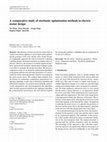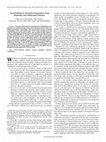Journal Papers by Gregor Papa
International Journal of Information Management, 2015
ABSTRACT Within highly competitive business environments, data mining (DM) is viewed as a signifi... more ABSTRACT Within highly competitive business environments, data mining (DM) is viewed as a significant technology to enhance decision-making processes by transforming data into valuable and actionable information to gain competitive advantage. There appears, however, to be a dearth of empirical case studies which consider in detail the initial stages in DM management to enable apt foundation for its later successful implementation. Our research applied a multi-method strategy to determine the critical success factors of embryonic DM implementation. We propose and validate, through a series of cases, a conceptual framework to guide practitioners’ adoption of DM. Our findings reveal additional issues for applied decision making in the context of DM success.

Computational Optimization and Applications, 2013
ABSTRACT The development of a simple, adaptive, parameter-less search algorithm was initiated by ... more ABSTRACT The development of a simple, adaptive, parameter-less search algorithm was initiated by the need for an algorithm that is able to find optimal solutions relatively quick, and without the need for a control-parameter-setting specialist. Its control parameters are calculated during the optimization process, according to the progress of the search. The algorithm is intended for continuous and combinatorial problems. The efficiency of the proposed parameter-less algorithm is evaluated using one theoretical and three real-world industrial optimization problems. A comparison with other evolutionary approaches shows that the presented adaptive parameter-less algorithm has a competitive convergence with regards to the comparable algorithms. Also, it proves the algorithm’s ability to finding the optimal solutions without the need for predefined control parameters.

ABSTRACT An initiative was introduced in one of the production facilities of Germany’s E.G.O. Gro... more ABSTRACT An initiative was introduced in one of the production facilities of Germany’s E.G.O. Group in order to enhance its SAP information system with a custom-made application for production-scheduling optimization. The goal of the optimization is to find a production schedule that satisfies different, contradictory production and business constraints. We show the challenges faced in the application of the multi-objective optimization approach, which is gaining influence in the management of production scheduling. We implement a memetic version of the Indicator-Based Evolutionary Algorithm with customized reproduction operators and local search procedures to find a set of feasible, non-dominated solutions. Such a memetic algorithm was applied to two real order lists from the production company. Additionally, we also lay out an efficient presentation of the multi-objective results for an expert’s support in decision making. This provides the management with the possibility to gain additional insights into how the production schedule dynamically reacts to changes in the decision criteria. We show that the multi-objective approach is able to find high-quality solutions, which enables flexibility when it comes to quickly adapting to specific business conditions.
Transport, 2013
ABSTRACT This paper compares two metaheuristic approaches in solving a constrained transportation... more ABSTRACT This paper compares two metaheuristic approaches in solving a constrained transportation scheduling problem, which can be found in transporting goods in emergency situations. We compared Greedy Search, Parameter-less Evolutionary Search and Ant-Stigmergy Algorithm. The transportation scheduling/allocation problem is NP-hard, and is applicable to different real-life situations with high frequency of loading and unloading operations; like in depots, warehouses and ports. To evaluate the efficiency of the presented approaches, they were tested with four tasks based on realistic data. Each task was evaluated using group and free transportation approach. The experiments proved that all tested algorithms are viable option in solving such scheduling problems, however some performing better than others on some tasks.
Engineering Applications of Artificial Intelligence, 2012
Planning problems can be solved with a large variety of different approaches, and a significant a... more Planning problems can be solved with a large variety of different approaches, and a significant amount of work has been devoted to the automation of planning processes using different kinds of methods. This paper focuses on the use of specific local search algorithms for real-world production planning based on experiments with real-world data, and presents an adapted local search guided by evolutionary metaheuristics. To make algorithms efficient, many specifics need to be considered and included in the problem solving. We demonstrate that the use of specialized local searches can significantly improve the convergence and efficiency of the algorithm. The paper also includes an experimental study of the efficiency of two memetic algorithms, and presents a real-world software implementation for the production planning.
The aim of this article is to present the work and the findings of an effort to improve the respo... more The aim of this article is to present the work and the findings of an effort to improve the response rate of direct mail. The purpose was achieved applying data mining techniques to the available data. The resulting predictive model can, given a set of characteristics of a person, determine probabilistically, whether the person is likely to respond positively to a direct marketing campaign with a purchase of a product or service. The work is based on the data of a Dutch insurance company which was published for the purpose of the CoIL Challenge 2000. The contest had the same aspirations as this article. Its results are discussed briefly in the last chapter.
ABSTRACT In this paper, we present a methodology for learning elementary-school mathematics onlin... more ABSTRACT In this paper, we present a methodology for learning elementary-school mathematics online. It is supported by a decision making system, based on evolutionary computation, which leads a student in selecting an optimal subset of math items to effectively upgrade the knowledge. We evaluated the system's effectiveness with the active participation of experienced teachers and students. The teachers evaluated solutions provided by the systems, judging the selection with respect to content areas and difficulty levels. The students were solving math items suggested by the system, gradually improving their knowledge. They both agreed that the system could effectively be used for e-learning.
Applied Intelligence, 2010
The paper describes an approach for the generation of a deterministic test pattern generator logi... more The paper describes an approach for the generation of a deterministic test pattern generator logic, which is composed of D-type and T-type flip-flops. This approach employs a genetic algorithm that searches for an acceptable practical solution in a large space of possible implementations. In contrast to conventional approaches the proposed one reduces the gate count of a built-in self-test structure by concurrent optimization of multiple parameters that influence the final solution. The optimization includes the search for: the optimal combination of register cells type; the presence of inverters at inputs and outputs; the test patterns order in the generated test sequence; and the bit order of test patterns. Results of benchmark experiments and comparison with similar studies demonstrate the efficiency of the proposed evolutionary approach.

IJICA, 2010
ABSTRACT When dealing with real-world problems, it turns out that there are many specifics of the... more ABSTRACT When dealing with real-world problems, it turns out that there are many specifics of the problem we are trying to solve. Since many algorithms that are being developed are evaluated and compared on test benchmark problems, they can simulate real-world problems up to some degree and specifics are not presumed and tested. To make algorithms efficient, such specifics need to be considered and included in the problem solving. In this paper, a real-world production scheduling problem is addressed. A typical approach with genetic algorithm turned out to be insufficient due to added complexity of many specifics. To successfully solve this problem, a memetic algorithm, which uses problem-specific local search procedures to improve solutions acquired by genetic algorithm, is proposed. It is shown that the use of such local search procedures can significantly improve the effectiveness and efficiency of the algorithm.

Applied intelligence, Oct 1, 2007
The efficiency of universal electric motors that are widely used in home appliances can be improv... more The efficiency of universal electric motors that are widely used in home appliances can be improved by optimizing the geometry of the rotor and the stator. Expert designers traditionally approach this task by iteratively evaluating candidate designs and improving them according to their experience. However, the existence of reliable numerical simulators and powerful stochastic optimization techniques make it possible to automate the design procedure. We present a comparative study of six stochastic optimization algorithms in designing optimal rotor and stator geometries of a universal electric motor where the primary objective is to minimize the motor power losses. We compare three methods from the domain of evolutionary computation, generational evolutionary algorithm, steady-state evolutionary algorithm and differential evolution, two particle-based methods, particleswarm optimization and electromagnetism-like algorithm, and a recently proposed multilevel ant stigmergy algorithm. By comparing their performance, the most efficient method T. Tušar . B. Filipič ( ) for solving the problem is identified and an explanation of its success is offered.

Systems, Man, and …, 2007
The main motivation for organizations and individuals to collaborate is to enable knowledge and r... more The main motivation for organizations and individuals to collaborate is to enable knowledge and resource sharing in order to effectively fulfill a joint business opportunity. This correspondence focuses on virtual organizations (VOs) and virtual teams (VTs), whose strengths lie in the range of competencies of their members, offered jointly through collaboration. One of the difficulties in VO and VT creation is partner selection using partners' mutual trust as one of the selection criteria. This correspondence provides an analysis of trust relationships based on the principal-agent theory, and proposes an approach to hierarchical multiattribute decisionsupport-based trust estimation applied to a network of collaborating organizations (VO) and a network of collaborating individuals (VT). The correspondence presents two case studies, one using a questionnaire-based approach and the other using automated reputation and collaboration estimation from data gathered by Web crawling.
J. Elektr. Eng., 2007
The paper presents an automatic technique for structure optimization of a deterministic test patt... more The paper presents an automatic technique for structure optimization of a deterministic test pattern generator (TPG). The TPG is composed of a linear register and a non-linear combinational function that can invert any bit in the generated patterns. Consequently, any arbitrary test sequence can be produced. This kind of a TPG is suitable for on-line built-in self-test (BIST) implementations where a set of deterministic test patterns is required. In order to reduce the gate count of the BIST structure a genetic algorithm (GA) is employed. In contrast to conventional approaches, a GA concurrently optimizes multiple parameters that influence the final solution. Experimental results on ISCAS benchmarks demonstrate the efficiency of the approach.
Engineering Applications of Artificial Intelligence, 2005
This paper presents a design approach for improvement of the efficiency of a universal motor, the... more This paper presents a design approach for improvement of the efficiency of a universal motor, the type of motor that is typically used in home appliances and power tools. The goal of our optimization was to find optimal values of the independent geometrical parameters of the rotor and the stator of the UM with the aim of reducing the motor's main power losses-they occur in the iron and the copper. Our procedure is based on a genetic algorithm (GA), and by using it we were able to significantly improve the motor's efficiency. The GA proved to be a simple and efficient search-and-optimization method for solving this day-to-day design problem in industry. It significantly outperformed a conventional design procedure that was used previously. r
An efficient technique for progressive lossless compression of volumetric data is described. It i... more An efficient technique for progressive lossless compression of volumetric data is described. It is based on the quadtree data structure and exploits the expected similarities between the neighboring slices. The proposed approach has better compression ratio than the octree method. A small amount of memory is required since only two slices need to be located in the memory at a time, which makes it suitable for hardware implementation. A built-in compression in volumetric scanners could considerably reduce the transfer and storage requirements for volumetric medical data.










Uploads
Journal Papers by Gregor Papa